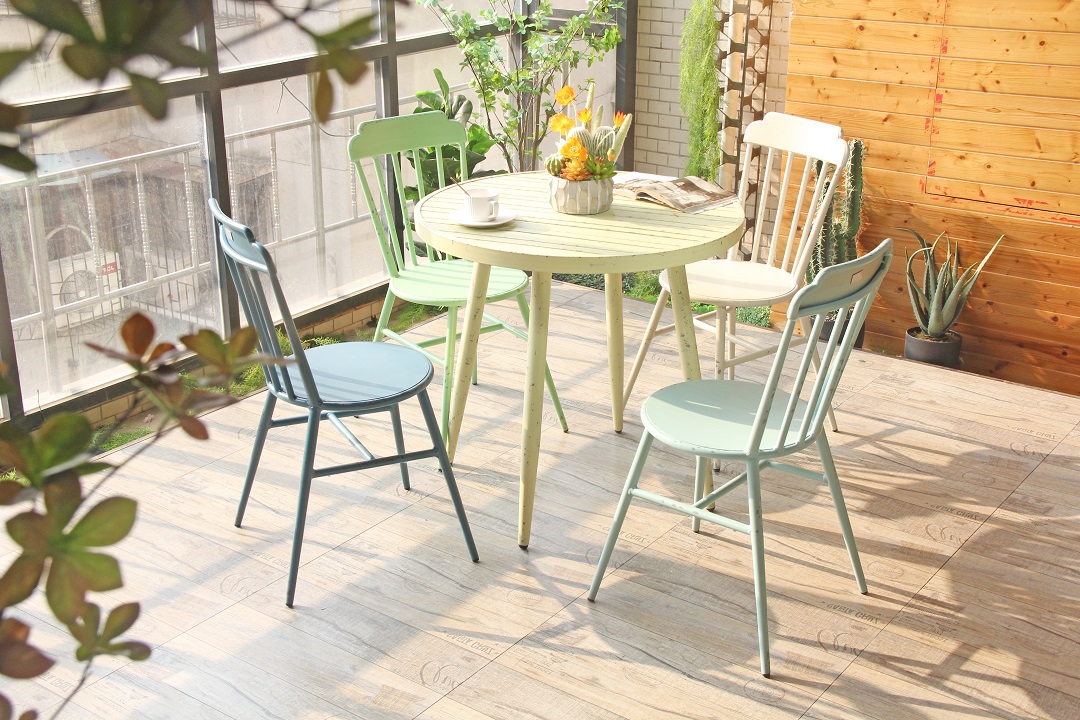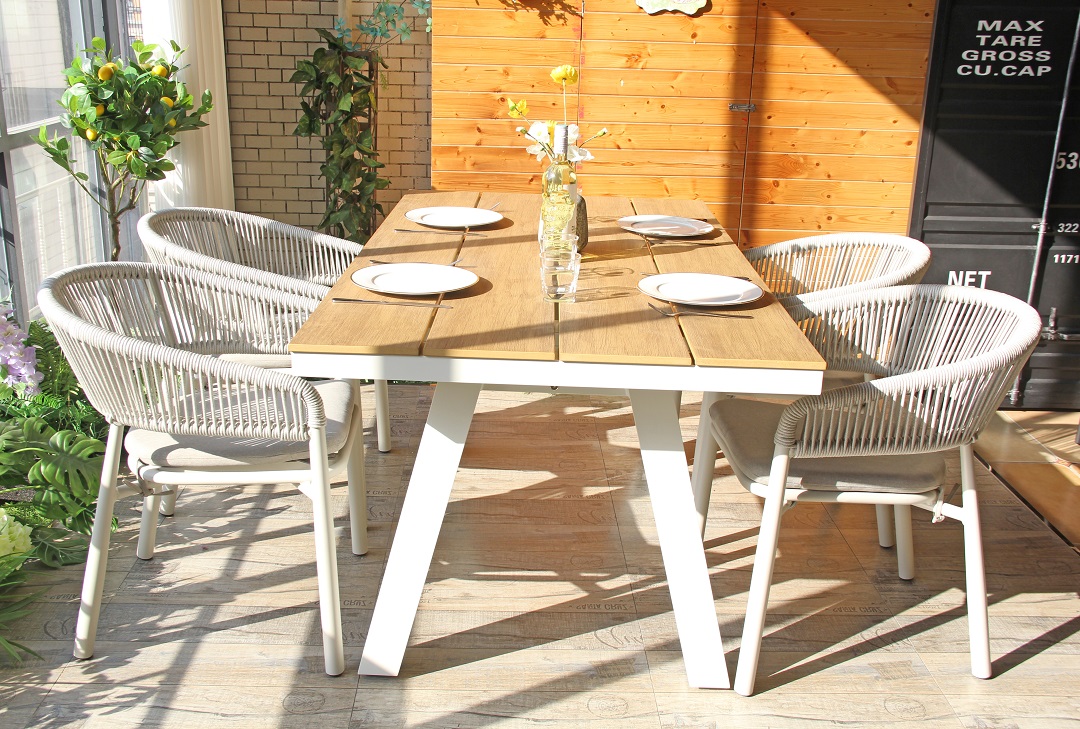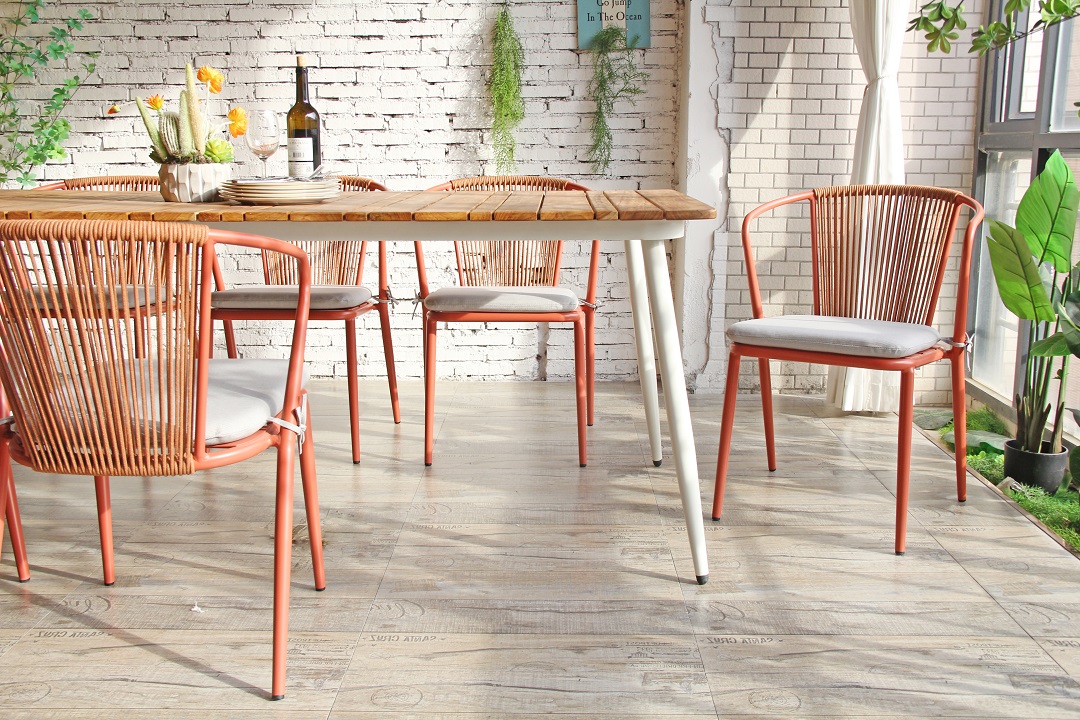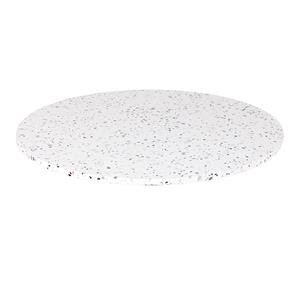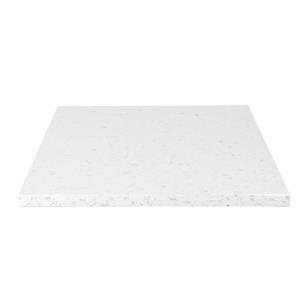How To Choose The Best Outdoor Garden Furniture?
I. Introduction: Crafting Your Perfect Outdoor Oasis
Your outdoor space is not just an extension of your home; It is a haven with unlimited potential, a place to relax, entertain, and enjoy the beauty of nature. Choosing the right outdoor garden furniture is the key to creating this dream oasis. It not only enhances the beauty and functionality of your outdoor area, but also ensures that you and your loved ones can enjoy comfort and pleasure for years to come. However, facing the dazzling array of choices in the market, from various materials to different styles, and even sets with different functions, choosing the most suitable outdoor furniture for your needs may feel overwhelming. This guide aims to provide you with a comprehensive perspective, helping you understand the key factors to consider when choosing outdoor garden furniture, ensuring that your investment is worth it, and ultimately creating your ideal outdoor living space.
II. Understanding Your Needs and Space
The most important step before you start browsing through various exquisite outdoor furniture is to gain a deeper understanding of your specific needs and existing space. This will help you narrow down your choices and ensure that the furniture you ultimately purchase perfectly fits your lifestyle and outdoor environment.
A. Define the Purpose of Your Outdoor Space
Firstly, think about how you would like to use your outdoor space. Is it the dining area for enjoying family dinner and hosting barbecue parties? Or do you prefer a comfortable resting area where you can read in the sun or have a drink with friends? Or do you need a multifunctional area that can meet your dining needs and provide a place for leisure and relaxation? Different uses will determine the type of furniture you need to purchase. For example, if you plan to hold a dinner party on a warm summer night, a spacious outdoor dining table and chairs will be essential. If you primarily envision a peaceful reading corner, comfortable outdoor seating and a few side tables may be more in line with your needs.
B. Measure Your Space: Small Balconies vs. Large Gardens
Understanding the size of your outdoor space is crucial. A small balcony or pocket garden is vastly different from a spacious backyard or terrace in terms of furniture selection. Accurately measure your space, including length, width, and any obstacles that may affect furniture placement (such as pillars, flower beds, or fixtures). This will help you determine the maximum size of furniture and avoid purchasing items that are too large or too small. For small spaces, space saving multifunctional furniture such as foldable furniture, stackable chairs, or wall mounted tables are ideal choices. For large spaces, you can consider large combination sofas, multi piece dining areas, or independent leisure areas to fully utilize the space and create different functional zones.
C. Consider Your Climate and Environment
The climate conditions in your residential area will directly affect your choice of outdoor furniture materials. For example, if you live in a rainy and humid area, it is crucial to choose materials with excellent moisture and rust resistance. If your outdoor space is exposed to strong sunlight all year round, materials that are UV resistant and fade resistant will be your first choice. Understanding these environmental factors can help you choose the most durable and time tested furniture, thereby extending its lifespan and reducing maintenance costs. For example, teak wood has excellent weather resistance due to its natural oil, while aluminum furniture is known for its lightness and rust resistance.
III. Choosing the Right Materials: Durability, Aesthetics, and Maintenance
The material of outdoor furniture is a key factor determining its durability, appearance, and level of maintenance required. Choosing materials that are suitable for your climate and lifestyle will ensure that your furniture can withstand the test of time and always maintain its beauty. Here are some common outdoor furniture materials and their characteristics:
A. Wood: Natural Beauty with Specific Care Needs
Wooden outdoor furniture is highly favored for its natural warmth and classic appearance, which can perfectly blend with the natural environment. However, different types of wood have significant differences in durability and maintenance requirements.
Teak: Teak is considered one of the best woods for outdoor furniture because it contains natural oils and has excellent waterproof, anti-corrosion, and insect proof properties. Teak furniture is very durable, able to resist cracking and warping, and gradually turns into a beautiful silver gray over time. Although teak furniture is relatively expensive, its excellent durability and low maintenance requirements (requiring only regular cleaning and occasional oiling to maintain its original color) make it a worthwhile investment. CDG Furniture extensively uses high-quality teak wood in its products, ensuring that our customers can enjoy outdoor furniture that is both aesthetically pleasing and practical.
Cedar and Redwood: These woods also have natural anti-corrosion and insect resistant properties, and are more cost-effective than teak. They usually present a beautiful red hue, but require regular sealing or dyeing to maintain their color and extend their lifespan.
Eucalyptus: Eucalyptus is a sustainable hardwood with similar characteristics to teak, but at a more affordable price. It also requires regular maintenance, such as oiling, to prevent cracking and fading.
B. Metal: Strength, Modernity, and Rust Resistance
Metal outdoor furniture is renowned for its sturdy, modern appearance, and versatility. Different metal materials have different characteristics and are suitable for different environments.
Aluminum: Aluminum is an ideal choice for outdoor furniture because it is lightweight, rust resistant, and easy to clean. Aluminum furniture is typically coated with powder to increase its durability and aesthetics, and offers a variety of color options. It doesn't require much maintenance and is very suitable for humid or rainy climates. CDG Furniture focuses on combining aluminum with innovative design to create a stylish and practical outdoor furniture collection that perfectly meets the needs of modern living spaces.
Steel: Steel is heavier and stronger than aluminum, but not as heavy as iron. Steel frame furniture is very durable, but if not properly treated, it may rust. Stainless steel is a better choice because it has excellent rust resistance, but at a higher price.
Wrought Iron: Cast iron is the strongest and heaviest of all metal outdoor furniture, so it won't be blown away by the wind. Cast iron furniture is very durable, but requires regular painting to prevent rusting. It usually requires a seat cushion to provide comfort.
C. Wicker and Rattan: Classic Charm with Modern Durability
Rattan and willow furniture are loved for their classic charm and comfort. Traditionally, these furniture pieces were made from natural materials, but modern technology has brought more durable synthetic alternatives.
Natural Wicker/Rattan: Natural wicker furniture is typically woven from rattan, willow, or other plant fibers. They have unique textures and lightweight characteristics, but are usually not suitable for long-term exposure outdoors as they are prone to moisture, mold, and fading. If choosing natural rattan weaving, it is recommended to place it in a sheltered area and store it when not in use.
All Weather Wicker/Resin Wicker: This synthetic wicker furniture is typically made of high-density polyethylene (HDPE), which has excellent weather resistance and can resist UV rays, moisture, and temperature changes. It is more durable than natural rattan weaving, easy to clean, and comes in a variety of colors and styles to choose from. CDG Furniture uses high-quality all-weather rattan materials and exquisite weaving techniques to bring you outdoor furniture that combines natural beauty with modern durability, so you don't have to worry about weather conditions.
D. Plastic and Resin: Affordable, Lightweight, and Easy to Clean
Plastic and resin furniture are budget friendly and easy to maintain choices, especially suitable for leisure and temporary use.
Plastic: Plastic furniture is typically made of polypropylene or other plastics, lightweight, easy to move, and clean. They are affordable, but may not be as durable as other materials, and prolonged exposure to sunlight may cause them to fade or become brittle.
Resin: Resin furniture is usually stronger than ordinary plastic and has better weather resistance. Many resin furniture are treated with UV protection to prevent fading. They are an ideal choice for moisture and rust prevention, and are easy to clean.
E. Fabric and Cushions: Comfort and Weather Resistance
The comfort of outdoor furniture largely depends on its seat cushions and fabrics. Choosing fabrics with good weather resistance is crucial.
Outdoor fabrics: Look for fabrics made from high-performance materials such as acrylic or polypropylene (Olefin) that are waterproof, UV resistant, mold resistant, and fade resistant. For example, Sunbrella ® The brand is renowned for its outstanding outdoor performance.
Quick Dry foam: high-quality outdoor cushions are usually filled with quick dry foam, which can dry quickly even after wet weather to prevent mold growth.
Removable and washable covers: Choose seat cushions with detachable and washable covers for easy cleaning and maintenance, extending the lifespan of the cushion.
IV. Sizing and Space Planning: Optimizing Your Outdoor Layout
Choosing the appropriate size of outdoor furniture and conducting reasonable space planning is the key to creating a functional and aesthetically pleasing outdoor area. No matter the size of your space, clever layout can make your outdoor life more comfortable and convenient.
A. Measure Twice, Buy Once: The Importance of Accurate Dimensions
Before purchasing any outdoor furniture, it is essential to accurately measure your outdoor space. This includes length, width, and any fixed structures that may affect furniture placement, such as walls, columns, flower beds, porches, or windows. At the same time, consideration should also be given to pedestrian pathways to ensure that there is still enough space for people to move freely after furniture placement, avoiding the risks of crowding and tripping. For example, in the dining area, there should be at least 90 centimeters (about 3 feet) of space behind each chair so that people can easily pull out the chair and seat it. For the leisure area, ensure there is sufficient legroom between the sofa and coffee table, while not making it difficult for the remote control or drinks to reach.
B. Furniture for Every Footprint: Tailoring to Your Space Size
Small spaces (balconies, terraces): For limited spaces, choosing compact, multifunctional, or foldable furniture is a wise decision. The compact Bistro Sets are perfect for two people dining or drinking coffee. Folding chairs and folding tables can be folded up when not in use, maximizing space release. Stacked chairs are also a good choice for saving storage space. In addition, consider the utilization of vertical space, such as chairs or benches with built-in storage functions, or folding tables that can be hung on the wall. CDG Furniture offers a range of exquisite and practical outdoor furniture designed specifically for small spaces, helping you transform limited areas into efficient and charming resting places.
Medium sized spaces (standard terraces, small gardens): This type of space provides more flexibility. You can consider a comfortable Patio Conversation Set, which typically includes a sofa, two armchairs, and a coffee table, perfect for friend gatherings and family leisure. If space permits, a small dining area can also be added. Modular outdoor sofas are an ideal choice for medium-sized spaces as they can be reconfigured according to your needs and spatial layout.
Large space (spacious backyard, large garden): With a large space, you can unleash your creativity and create multiple functional areas. You can set up a large outdoor dining set to accommodate more guests. At the same time, a separate Lounge Area can be planned, equipped with large combination sofas, lounge chairs, and outdoor carpets to create a luxurious and comfortable atmosphere. You can even consider adding an outdoor bar, fire pit area, or sunbathing area by the pool. CDG Furniture has rich customization experience and a diverse product line, which can meet the various needs of large spaces for furniture size, quantity, and style, helping you create magnificent outdoor landscapes.
C. Creating Flow and Zones
When planning the layout of outdoor furniture, it is crucial to consider "flow lines" and "zoning". Streamline refers to the path through which people move in space, and it should be ensured that it is unobstructed. Regional division refers to dividing a large space into different "rooms" based on their functions, such as dining areas, rest areas, reading corners, etc. Using outdoor carpets, screens, plants, or furniture of different heights to define these areas can increase the sense of hierarchy and fun in the space.
V. Style and Design: Harmonizing with Your Home and Landscape
The style and design of outdoor furniture should be coordinated with the architectural style, interior decoration, and surrounding landscape of your house, creating a unified and pleasant visual experience. Choosing the right style not only enhances aesthetics, but also reflects your personal taste.
A. Matching Your Home’s Architectural Style
Modern Minimalist: If your house has simple lines, large areas of glass, and open design, then choosing modern style outdoor furniture will be the ideal choice. This type of furniture is usually made of materials such as aluminum, stainless steel, or synthetic rattan, with smooth lines and neutral colors (such as black, white, gray, beige), emphasizing the unity of functionality and form. CDG Furniture has profound expertise in modern minimalist style outdoor furniture design. Our products perfectly embody the essence of modern outdoor life with their exquisite craftsmanship and forward-looking design.
Traditional Classic: For houses with traditional architectural styles such as Victorian, colonial, or country villas, choosing outdoor furniture with classic shapes and details will be more coordinated. Cast iron, solid wood (such as teak or mahogany), or wicker furniture with carved details are all good choices. Colors can lean towards natural tones or dark tones, creating an eternal sense of elegance.
Rustic Farmhouse: If your home is in rural or farmhouse style, choosing outdoor furniture with natural textures and a rugged feel will be perfect. Untreated wood, recycled wood, or wicker furniture with a hand woven feel can all blend well into this style. Paired with comfortable cotton and linen cushions and rustic decorations, create a warm and natural atmosphere.
B. Color Palettes and Textures
The color and texture of outdoor furniture have a significant impact on the overall atmosphere. You can choose colors that match the exterior of the house, or use pillows and accessories to add jumping colors.
Neutral Tones: Grey, beige, brown, and white are classic neutral colors for outdoor furniture that are versatile and not easily outdated. Neutral colored furniture can serve as a canvas, allowing you to easily change the style of outdoor spaces by replacing pillows, carpets, and plants.
Natural Hues: Green, blue, and earthy tones blend seamlessly with the surrounding natural environment, creating a peaceful and harmonious feeling.
Accent Colors: Enhance visual appeal by selecting bright colored pillows, flower pots, or outdoor artworks. These small items have relatively low prices and are easy to replace, making them a good way to try trendy colors.
Textures: Different materials will bring different texture sensations. Smooth metal, rough wood, delicate rattan or soft fabric, by combining different textures, can increase the layering and richness of the space.
C. Incorporating Personal Touches
In addition to the furniture itself, adding some personalized decorations can make your outdoor space more personalized and charming. Outdoor carpets can add color and comfort to a space. Outdoor lighting, such as string lights, floor lamps, or solar lights, can not only provide functional lighting, but also create a warm atmosphere. Plants and flowers are essential elements of outdoor spaces, bringing vitality and energy. Artworks, sculptures, or unique decorations can also showcase your taste.
VI. Maintenance and Care: Ensuring Longevity and Beauty
Proper maintenance and upkeep of outdoor garden furniture is key to ensuring its durability, aesthetic appeal, and maximizing return on investment. Different materials require different care methods, and understanding these details will help you easily cope.
A. General Cleaning Tips for All Materials
No matter what material your outdoor furniture is made of, regular cleaning is essential. Dust, pollen, bird droppings, and environmental pollutants can accumulate over time, damaging the surface of furniture and affecting its appearance. Usually, you can use mild soapy water and a soft cloth or brush to clean. After cleaning, be sure to thoroughly rinse with clean water and let the furniture dry completely to prevent water stains or mold growth. For stubborn stains, you can try using specialized outdoor furniture cleaners, but be sure to test them in inconspicuous places first.
B. Material-Specific Care
Wooden furniture: Wooden furniture needs to be cleaned regularly and treated according to the type of wood and climate conditions. Teak furniture only needs regular cleaning, and if you want to maintain its golden brown color, you need to apply oil every year. Other woods may need to be sealed or dyed regularly to prevent cracking, fading, and rotting. In winter or humid seasons, it is recommended to store wooden furniture in a dry and sheltered place, or use breathable furniture covers.
Metal furniture (aluminum, steel, cast iron): Aluminum furniture usually only needs to be cleaned with soapy water. Although steel and cast iron furniture are sturdy, they are prone to rusting, so special attention should be paid. Regularly check for scratches or paint peeling, and promptly repair them. For cast iron furniture, regular repainting may be necessary to prevent rusting. When not in use, it is recommended to use a furniture cover or store indoors.
Rattan and Willow Furniture (Natural and Synthetic): Natural rattan furniture should be avoided from prolonged exposure to sunlight and rain. It is recommended to place it in a shaded area and regularly wipe it with a damp cloth. Synthetic rattan weaving (all-weather rattan weaving) is more durable and can be cleaned with soapy water. For dust in weaving gaps, a vacuum cleaner or soft bristled brush can be used to remove it. The high-quality all-weather rattan material used in CDG Furniture has excellent UV resistance and waterproof performance, greatly reducing the complexity of daily maintenance and allowing you to enjoy worry free outdoor life.
Plastic and resin furniture: These types of furniture are the easiest to clean and usually only require soapy water and a soft cloth to wipe. For stubborn stains, a mild cleaning agent can be used. To prevent fading, it is recommended to choose products with UV protective coatings and store them in a cool place or use furniture covers when not in use.
C. Cushions and Fabrics Care
Outdoor seat cushions and fabrics also require regular cleaning and maintenance. Most outdoor seat cushion covers are detachable and washable, and can be machine washed or hand washed according to the manufacturer's instructions. For non removable seat cushions, mild soapy water and a soft brush can be used for local cleaning. After cleaning, make sure the seat cushion is completely dry to prevent mold growth. It is recommended to store the seat cushion in a dry storage box or indoors when not in use or in adverse weather conditions.

